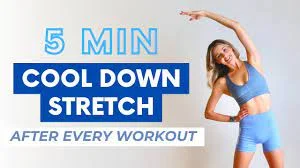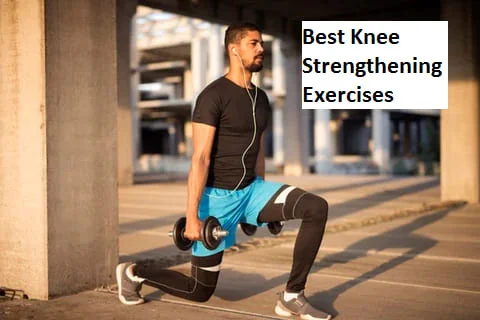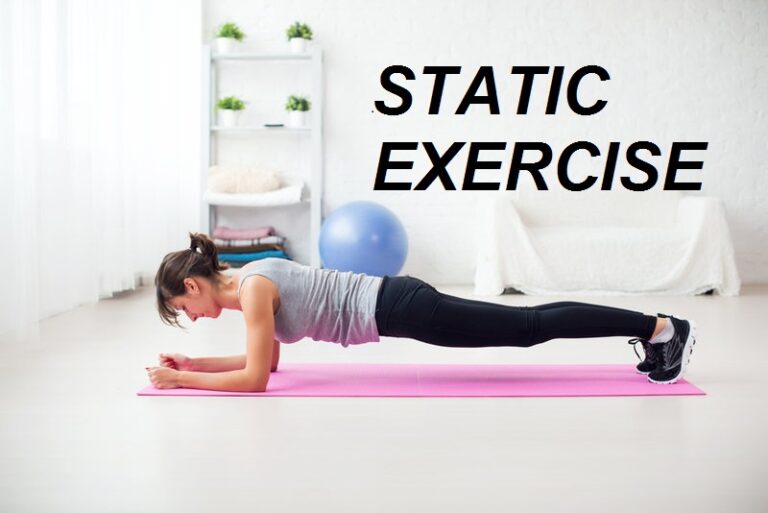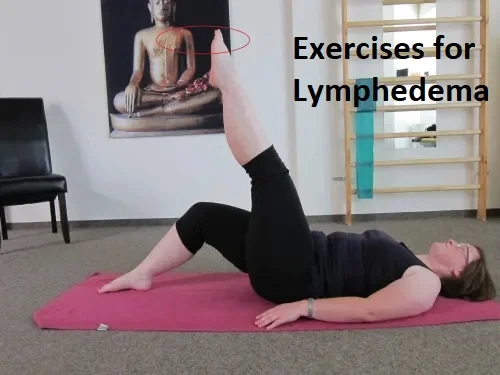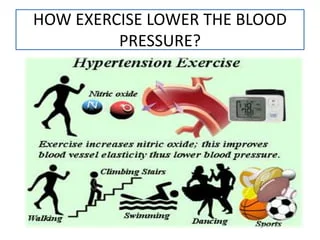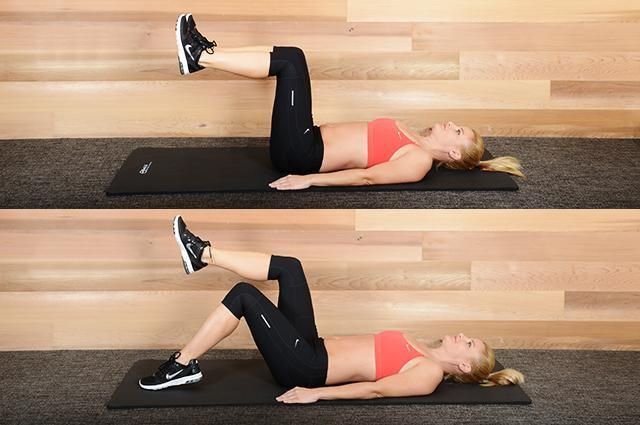47 Essential Cool Down Exercises for a Post-Workout Recovery
Introduction
We all understand how important it is to warm up before exercising, but we rarely spend the time necessary to cool down afterward. I understand that you must return to your to-do list after your workout is over.
However, just a few minutes to stretch can go a long way toward avoiding pain and damage. The appropriate stretches are also essential: Dynamic stretching is the primary goal of pre-workout warming up. However, holding static stretches after exercising is the best approach to relieve muscle tension and aid in the body’s recovery.
This cool-down stretch technique includes static stretches to loosen up your whole body, from the top of your head to the soles of your feet. Following a cardio or HIIT workout to warm up your muscles is a terrific method to get a thorough stretch.
It’s crucial to breathe when you stretch. It aids you to go deeper into each stretch and allows the body and mind to relax. After a workout, normally advise the clients to stretch while taking deep breaths in and out through their noses. This makes it easier for the body to use breathing to relax the nervous system. However, feel free to breathe normally after an aerobic workout if you’re short of breath, make sure to inhale with the use of your nose, and exhale with the use of your mouth
you should conduct cooldown exercises to assist you in recovering from your hard work. Stretching and cool-down exercises lessen the risk of injury, increase blood flow, and lessen the strain on your heart and other muscles.
Before continuing with the usual workouts, you’ll also lower the blood pressure, body temperature, and heart rate to their normal levels.
Consume at least ten minutes of cooling down after the training. For some of the more effective methods, continue reading. You can combine the exercises that best attract you from this point on to develop your own workout recovery and relaxation program.
What stretches and exercises make the finest cool-downs?
The finest activities to do after a workout to cool down aren’t compiled into a definite list. However, a productive cool-down regimen should consist of static stretches and 5 to 10 minutes of lower-intensity activity. You can begin your cooldown after running by moving from running to a gentle jog or brisk stroll. You can then attempt some static stretches.
As you gradually reduce your exercise level, light cardio maintains your blood circulation. Static stretches ought to concentrate on the muscles you use during your workout. For instance, after cycling, you should concentrate on your quads, hamstrings, and glutes. Stretching your arms, shoulders, and back after an upper-body strength-training session is important.
Exercises to Cool Down
Shoulders cross-body stretch
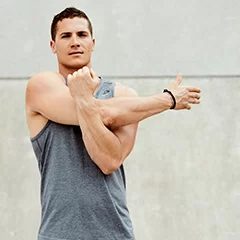
Since the shoulders have the most range of motion of any body part, stretching them after upper-body exercises is crucial. Stretching your shoulders might help you feel less stress and pain in your muscles. After a workout, they might help you feel more at ease by releasing tension and stress.1 How to do a cross-body shoulder stretch is shown here.
how to execute: Stand with your feet shoulder-width apart, your back straight, and your arms at your sides.
Raise your right arm out in front of you, keeping it parallel to the ground and pointing downward with your palm.
Holding your right arm above the elbow with your left hand. To intensify the stretch, gently pull your right arm in the direction of your left side.
For 20 to 30 seconds, hold.
After letting go of the stretch, switch sides.
Overhead triceps stretch
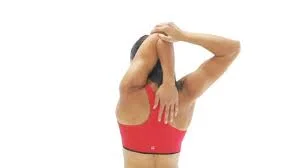
The connective tissues in your upper body and joints can be released and made more flexible by stretching the triceps. Your range of motion could also get better. The way to do an overhead tricep stretch is as follows.
The overhead triceps stretch, as the name indicates, focuses the triceps on the back of your upper arm. It’s a fantastic addition to any post-swimming, post-rowing, or post-lifting cooldown program.
how to execute: Stand with your feet hip-width separated and the shoulders backward.
Your right arm should be bent such that your palm is in the middle of your upper back. Raise your arms beyond the head.
Deepen the stretch in your right tricep by placing gentle pressure with your left hand on your right elbow.
pause for 20 to 30 seconds before changing the sides
Butterfly stretch
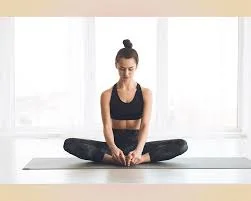
A butterfly stretch helps calm your nervous system and assists your body in readjusting after exercise. Additionally, it can help to loosen up the hip joints and lessen stiffness.3 To add a seated butterfly stretch to your cool-down routine, follow these instructions.
The groin and adductor muscles in your inner thighs are the significant areas of focus of the butterfly stretch. In addition, it helps to open up stiff hips and connect to the lower back.
how to execute: Take a seat with your knees bent and your feet flat on the ground.
Put the soles of your feet together in front of you and let your knees sag out to the sides. You should utilize your hands to preserve the feet together.
Bend toward your feet while keeping your back straight and placing your elbows on the inside of your thighs.
To extend the stretch even more, softly press down with your elbows.
Repeat two to four times after holding for 20 to 30 seconds.
Standing quadriceps stretch
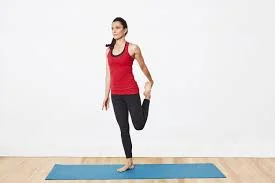
By stretching your quadriceps while standing, you engage the muscles that run along the front of your leg. It can ease muscle strain and knee pain. And following a run or a session of lower-body strength training, it’s a great activity to do to cool down.
how to execute: Carry a straight stance while standing. For support, you can grasp the back of a sturdy chair or counter.
Your right knee should be bent so that your heel is facing down.
Pull the top of your foot gently to deepen the stretch and bring your heel closer. Try to maintain a straight line between your knees.
After holding for 20 to 30 seconds, move to the left side.
On each side, repeat 2 to 4 times.
Standing hamstring stretch
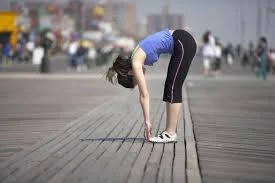
The hamstrings at the back of the thighs are energized by standing hamstring stretch. You may increase flexibility, loosen up tight muscles, and reduce knee pain by performing the standing hamstring stretch.
how to execute: Preserve proper posture as you stand behind a yoga block or exercise step.
Your right leg should be raised, and you should grow your heel on the step with your toes pointed upward. Straighten your right knee.
Leaning toward your right leg, extend your arms straight up as you bend from your hips.
Feel the stretch in your right hamstring as you hold the position for 20 to 30 seconds.
Change sides to the left.
On every side, repeat 2 to 4 times.
Wall calf stretch
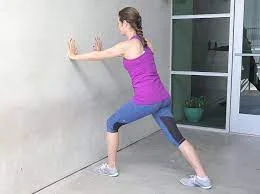
A tight calf might be relieved by the wall calf stretch, which lengthens the muscles in the back of the leg. Stretching the calves should assist you in chilling down as well as reduce tension. After an exercise session, a calf stretch can help your leg muscles feel more free and relaxed. A standing calf stretch can now be included in your cool-down program.
how to execute: stand with your feet hip-width apart and your arms by your sides about an arm’s length away from a wall.
Put your palms flat against the wall at chest and shoulder levels, shoulder-width apart.
Keeping both feet flat on the ground, take a step back with your right leg.
You put your weight on your hands, bend your left, and lean forward.
Feel the strain in your right leg as you press your right heel down.
After holding for 20 to 30 seconds, switch sides.
Calf stretch with a chair
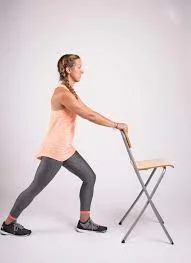
Hold the back of a chair or brace your hands on a wall while keeping one leg straight with the heel on the floor.
Slowly bending the other knee and your elbows while twisting a little forward will cause your calf to stretch.
Then, switch to the other leg and hold for at least 30 seconds.
Seated single-leg forward bend
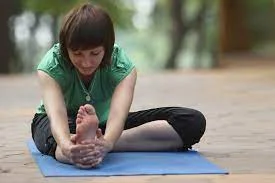
Your muscles will remain flexible if you practice yoga frequently. You may stretch your hamstrings, calves, and lower back while seated in this pose which is suitable for beginners. It might be a better choice for people who have balance issues.
As you sit up straight, place your heels on the floor and point your toes upwards.
Your right leg should be bent, with the heel pointing toward your groin and the knee bent to the side. On your left thigh, you can prop up your right foot. Your left leg should remain straight while being slightly angled to the side as if creating the letter V.
As you extend your arms upward, take a deep breath.
Breathe out as you slant your hips toward your left foot. Depending on your flexibility, place your hands on your left shin, ankle, or toes.
After holding for 20 to 30 seconds, switch sides.
Single knee to chest stretch
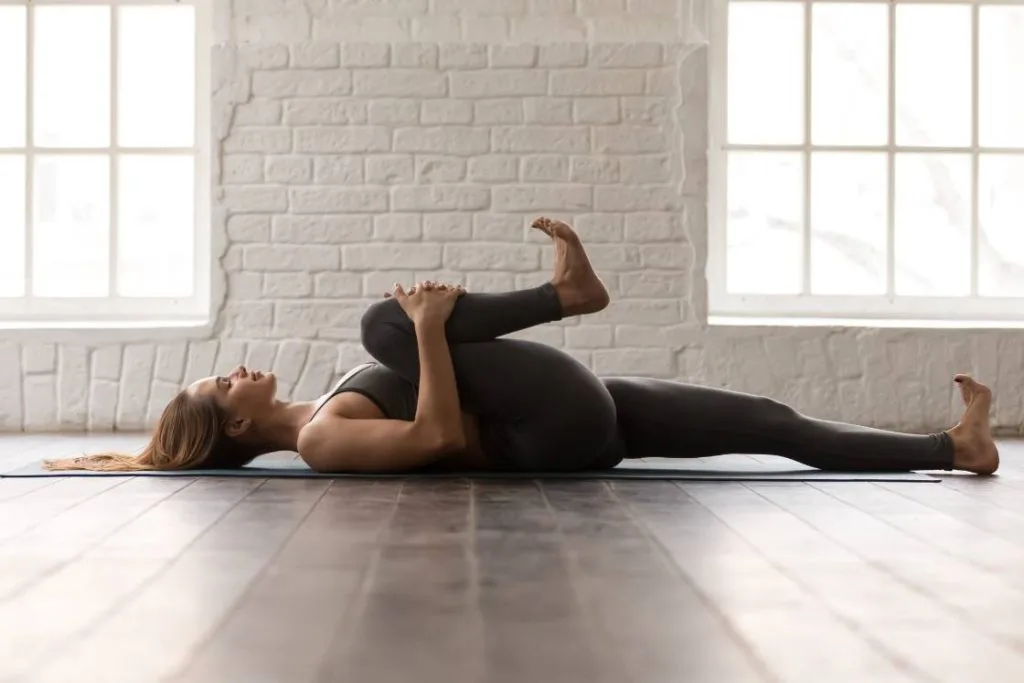
The back, hip, and glute muscles can be stretched by bringing one knee to the chest. Both spinal mobility and low back discomfort may benefit from it.
Maintaining straight legs and your heels on the ground, lie flat on your back.
As closely as you are able, bend your right knee and bring it up to your chest. You can gently move your right knee closer by holding the back of your right leg.
Keep your left leg straight and your lower back pressed onto the floor while holding for 20 to 30 seconds.
Change sides.
doing 2 to 4 times on the individual side
Seated Hamstring stretches
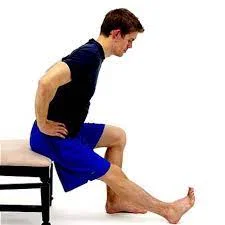
The broad muscle groups in the back of your thighs are your hamstrings. Hamstring stretches help to loosen up tight tendons and hips.2 Here’s how to stretch your hamstrings while standing.
initiate by sitting down and extending your legs.
Your right foot’s sole should be placed against the inner of your knee.
Reaching for the foot of the extended leg requires bending forward at the waist.
As much as you can, stoop forward.
For 20 to 30 seconds, hold.
On the opposite side, repeat.
Conduct these movements more slowly and gently than you would during a typical workout. As you calm down, take deep breaths to help your muscles receive oxygen, reduce tension, and encourage relaxation.
Brisk walking or jogging
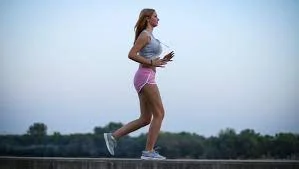
One of the simplest routes to relax the body is to do a brisk walk. Follow 3 to 5 minutes of brisk or easy walking with 3 to 5 minutes of mild jogging.
Stretch for the top body
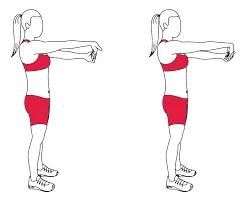
Whether you’re sitting or standing, interweave your fingers and point your palms upward.
As much as you can while maintaining a straight spine, draw your hands up and back.
After that, stretch your hands up and back while positioning your left arm in front of your right.
Seated toe touch
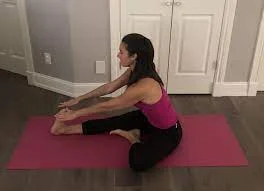
One leg should be extended in front of you while you sit. further leg bending
your arms up.
twist forward by creating a bend at your hips.
Attempt to touch the big toes with the usage of the hands.
For up to a minute, maintain a seated toe-touch posture.
Pose with Knees to Chest
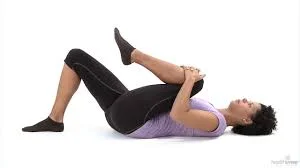
Your left leg should be bent when you lay on your back.
With your fingers wrapped over the front of your right tibia bone, bring your right knee in close to your chest.
For up to a minute, maintain a knee-to-chest posture.
On the other side, repeat.
2 to 3 times on a day every side.
Reclining butterfly pose
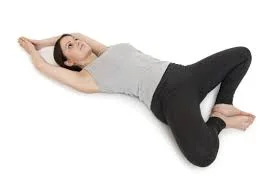
Kneel out to the sides while lying on your back with your feet together at the soles.
Place your arms aloft or next to your body.
For up to five minutes, maintain a reclining butterfly posture.
Child’s Pose

Reach your arms ahead or alongside your body as you slide back to a sitting position on your heels from the tabletop position.
Breathing deeply, let your chest sink into your thighs.
the forehead should be on the ground/floor.
Seated quadriceps stretch
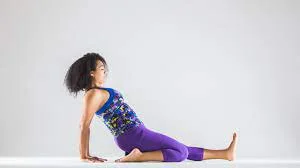
Bend your right knee while seated and move your right heel toward your buttock.
your back, with your hands behind it.
Don’t stretch one of your knees out to the side; maintain them in line with one another.
For 30 seconds, maintain seated quads stretch posture.
On the other side, repeat.
2 to 3 times on the individual side.
Ear-to-shoulder stretch
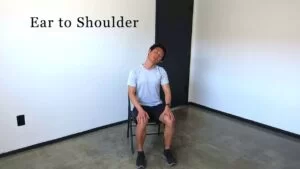
Look directly forward.
tilt the ear toward your shoulder by rotating your head. Preserve your shoulder far from your ear.
For 30 seconds, maintain the stretch.
Stay peaceful and move gradually back to your beginning position.
Repeat the ear-to-shoulder stretch while tilting your head to the opposite side
two to three sets in the day
Chin-to-chest stretch
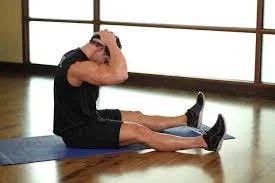
Try the chin tuck to relax tight neck and shoulder muscles:
softly position your hands behind the head.
Look directly forward.
Put your chin close to your chest.
For 30 seconds, maintain the chin-to-chest stretch. Back of your neck stress will be felt.
Remain relaxed as you move slowly back to your beginning position.
Repeat 5 times
two sets in a day
Armpit stretch
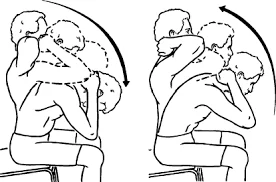
Put your elbows out to the side of the body and place your hands back on your head. Permit your head to rest back into your hands this time. With your back slightly curved, tilt your chin upward and stare upward toward the ceiling. Release after holding for a few seconds of breaths.3 reps
two to three sets
Standing side reach
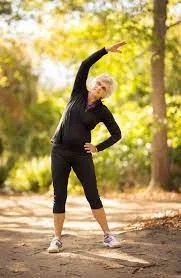
Here’s how to perform the standing side reach so you can relax your shoulders, back, and neck.
The simpler it will be to balance, the more broad your posture should be. Stand tall with your feet at least hip-width apart. Your left hand should be by your side, palm facing your thigh.
Lengthen your right elbow and shoulder fully as you elevate your right hand far above your head. Your fingers should be pointing upward.
Lean to the left while keeping your right arm raised high. When you begin to feel a pulling sensation on the right side of your body, continue to lean and drop your left hand.
As you stretch, let your neck slip and drop in.
After five to ten seconds, pause here before going back to where you started.
On the opposite side, repeat.
For 10 to 20 repetitions, keep alternating. For a stretching workout that provides long-lasting relief from tension, do two to three sets.
Standing lunge
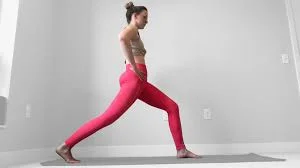
Step your right foot forward while keeping your back leg straight while standing with your feet as wide as your hips. As you rise to your back feet, bend your right knee so that it is over your ankle. push the belly region inward toward the spine. After noticing a stretch at the front of your right hip, alter the sides. three in day
The quadriceps, gluteus, hamstrings, calves, transverse abdominis, obliques, multifidus, and erector spine were all worked.
Standing lunge with a side reach
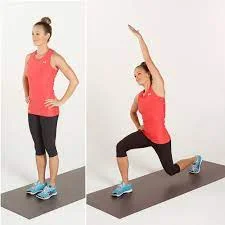
Lunge forward while standing and then raise the opposing arm of the bent leg to the ceiling. Moving your arm out to the side of the bent leg while bending at the waist. The whole side of the body gets lengthened by doing a standing lunge with a side reach, from the straight leg behind you up to the side waist and hip flexor. preserve for 10 counts and then alter the sides, two to three times in day
Standing single-leg hamstring stretch

Step forward with your right foot, flexing it and straightening your leg. Then, while turning at the waist, tilt forward over the straight right leg while bending your left knee. You should feel a stretch in your calf and down the back of your leg. After preserving for a few counts, alter sides. twice each day
Standing figure four
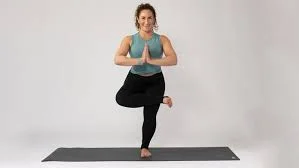
Carry the right leg up while standing with your feet as wide apart as your hips. Flex the left knee out to the side and cross the right ankle across the left thigh. As you’re going to walk into a chair, lean back. Here, there should be balance. Bend your right foot. If you’d like, gently press your hands into your right thigh to widen it a bit more. figure four exercise must also be conducted while seated. Once you’ve held for a few breaths, change sides.3 to 5 reps, two times a day
Keep your feet in mind, They receive a workout too, particularly during cardiac exercise, considering the fact that they are frequently overlooked when it comes to stretching.
Supine figure four
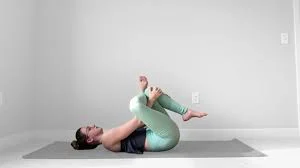
Your hips and buttocks can be stretched out with the figure-four stretch. These muscles can be stretched to increase their flexibility and range of motion. After an exercise, resting down can also assist in dropping your pulse rate and stabilize your breathing. Here’s a figure-four stretch exercise.
the sole of the feet should be flat on the ground as you lie down on your back with your knees bent.
Forming a figure four, move your right ankle to your left knee with your foot’s sole towards the left.
By wrapping one arm around the outside of your bent knee and the other via the center of your figure-four, grasp your hands behind your hamstring. Maintaining your knee from turning inward, slowly pull the bent leg toward your chest using your hands.
Restart on the contrasting side after maintaining for 20 to 30 seconds. two sessions in a day
Foot rock
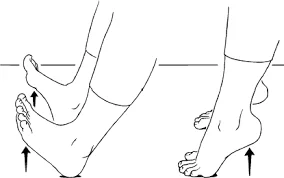
Rock onto your heels stretch your toes while you are sitting straight and wear without your shoes. Elevate your heels off the ground while keeping your toes set down, and then rock forward on your arches and the soles of your feet. Ten times in total. two to three sessions per day
Toes splay
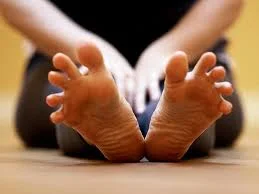
With your feet flat on the floor and your knees bent 90 degrees, sit up straight. Toes should be spread as wide as possible. Hold for 5 seconds. Release. Ten times in total. two to three sessions per day
Wide leg forward fold

Your hip flexibility will be greatly improved by the wide-leg forward fold. It increases circulation and brings your heart rate back to a resting rhythm when you are standing because it lowers your head below your heart. How to include a wide-leg forward fold in your cool-down exercise is shown here.
Position your feet separately as you stand.
When you inhale, raise your arms straight up toward the ceiling.
As you exhale, bend at the hips and bring your hands down to the ground in the middle of your stance.
Keep your back straight and take a moment to rest your hands on your shins.
If you can, deepen the stretch by maintaining your legs straight not flexing the knee, and placing your hands directly on the floor in the middle of your pose
After holding for 20 to 30 seconds, lift your head up. two sessions on alternate day
Floor scorpion
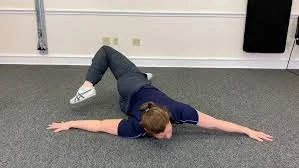
The lower back, hips, and buttocks muscles can be stretched and released with the floor scorpion exercise. it can ease tension and lessen stress. performing the floor scorpion as follows. likewise called vrischikasana
how to execute: Laying face down on the floor, forming a T with your arms, and extending your legs straight out along the floor are the first steps.
To keep your spine in a neutral position, softly rest your chin on the mat while looking down.
preserve your shoulders, upper back, and chest in place by lightly pressing your palms into the ground.
By bending your right knee to a 90-degree angle, you can raise your leg.
The toes on your right foot should be touching the ground outside of your left leg as you move your right foot over your left leg. Your lower back and hips should rotate, but your upper body should stay still.
Before changing sides, maintain for one to two minutes and then revert to a T position.
5 to 10 reps, two to three sessions in a day
90/90 with folding forward
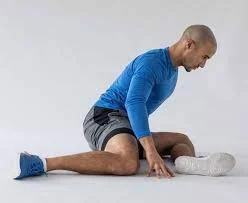
The 90/90 stretch is a fantastic approach to improve hip mobility and lessen pain from strain. After working out, do this while your muscles are still warm to help minimize lactic acid, which can lead to stiffness in the future. Achieving improved hip rotation will also help future workouts go better and lessen lower back pain. performing a forward fold and 90/90 stretch.
how to execute: utilize a floor seat.
The sole of your left foot should be pointing right and your left leg should be bent 90 degrees in front of your torso.
Bend your right leg at a 90-degree angle with your hip rotating inward, placing your shin and ankle on the floor.
Hold your right knee and hip in alignment.
Once both legs are 90 degrees from each other, sit up tall to maintain a straight back.
Bend forward and extend your arms out from your head while keeping equal weight on both hips.
Repeat on the other side after holding for a minute or two.
5 to 7 reps, two sessions in a day
Downward-facing dog
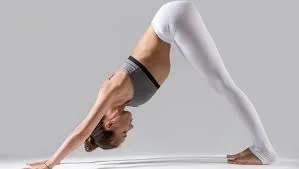
Your body and mind can be brought back into equilibrium by doing the downward dog. Additionally, because it is an inversion, your head is lower than your heart. Your body’s balance is restored, circulation is improved, and stress is eased. Here’s a demonstration of the downward dog.
Start in a tabletop position with your knees under your hips and your hands shoulder-width apart on the floor with the palms facing up.
Spread your fingers broad and fold the toes underneath.
Draw your hips up toward the ceiling by pushing up with your hands and the balls of your feet.
As you raise your knees off the floor, straighten your legs.
Deeply inhalation and exhalation while stretching your upper back, the backs of your legs, and the soles of the feet. Also, relax your neck and head.
For 30 to 60 seconds, hold.
Head to knee side bend
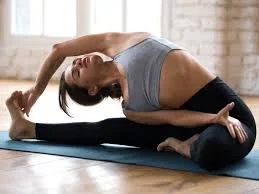
Put your left foot into your right thigh while seated and stretch your right leg.
Elevate your arms upwards and position your body such that it is side by side with the inner of your right leg.
Fold sideward by hinging at the hips and resting your hands on the ground or your body.
For up to a minute, maintain a head-to-knee side bend posture.
On the other side, repeat.
Standing forward bend
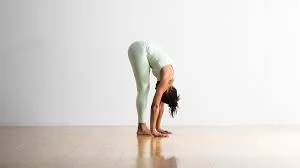
From a standing position, progressively bend forward by hinging at the hips.
Maintaining a small bend in your knees, lengthen your spine, and let your head fall heavily to the floor.
Put your hands on the floor, interlace your hands behind your back, or hold your opposing elbows in front of or behind your thighs.
For 30 seconds, maintain a standing forward bend posture.
You can adjust this stretch if your hands are too high off the floor. Instead of the floor, place your hands on a block or other solid object. You’ll continue to gain the same advantages
Pose with your legs up the wall
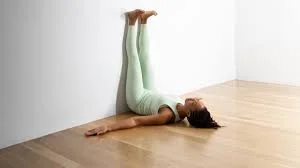
Set your right side of the body against a wall while you sit.
As you lean on your back, sway your legs upward along the wall.
Position your hips close to the wall or against it.
Put your arms at your sides, in front of you, or overhead.
For up to five minutes, maintain legs up the wall posture.
two to three sessions in the day
Corpse pose
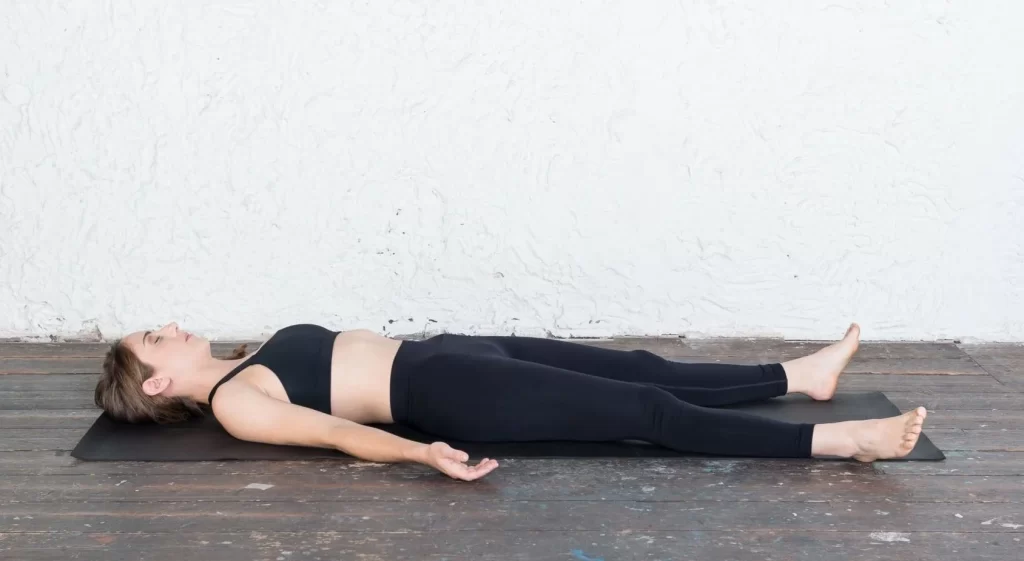
Your feet should be slightly wider than your hips and spread out to the sides while you lay on your back with your arms beside your body with your hands facing up.
Release any tightness or stress in your body by relaxing.
As you inhale deeply, let your body sag heavily to the ground.
Maintain corpse posture for at least five minutes.
2 to 3 times a day
Supine spinal twist
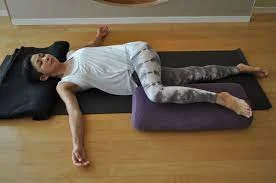
Your lower back’s muscles can become more relaxed and limber by doing a supine spinal twist. After difficult weight-bearing tasks, this can reduce tension and relieve stress.4 Here’s how to perform a spinal twist while reclining.
Lay backward with your legs outstretched to start.
With your hands facing down, extend your arms out in a T shape perpendicular to your body.
Your left knee should be bent to a 90-degree angle, then lowered in the direction of your right. Your left knee should be facing the ground with the inner facing up.
Rotate your spine while attempting to keep your shoulders level with the ground.
Tilt your head to stare at your right fingertips as opposed to your bent knee.
Lie back and let gravity drag your knee toward the floor as you stretch.
preserve for 30 to 60 seconds then alter the legs
two to three times a day
Marching arm circles
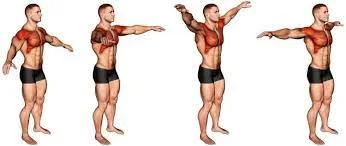
Put your feet shoulder-width apart while standing and raise your arms parallel to the ground.
Make short, controlled movements with your arms forward, then gradually enlarge the movements until you feel a stretch in your triceps.
After around 10 seconds, change the circles’ direction.
8 to 10 times, make a forward arm circle.
Eight to ten times, make a circle with your arms.
two times a day
Body shakes
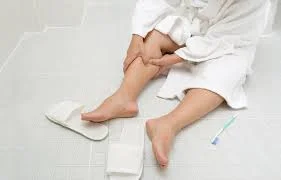
Vibrate your right arm softly, then vibrate your left arm, and finally both arms simultaneously.
Shake the left leg first, then your right leg.
Shake the hips, your head, and your entire body after that.
Give every bodily part a 15-second shake
two times a day
Cat cow
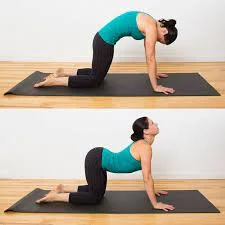
On a yoga mat, get down on your hands and knees.
Take a breath in, lower your tummy, raise your head, and look up at the sky.
Inhale, curve your spine, lower your head, and direct your attention to your belly button.
Repeat.
Bent knee cross-body stretch
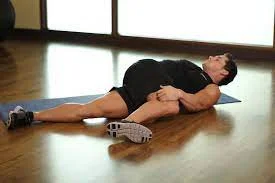
How to perform it: While twisting through your lower back, lay on your back and sway one leg over the other. For balance, extend both arms to the side. As much as you can, attempt to maintain your shoulder blades on the floor. The opposite rotation should be resisted by your upper body. 30 seconds of holding, then alternate sides.
Why it works: This exercise stretches the obliques and lower back muscles. A healthy back requires strengthening your core muscles. This exercise also stretches your sacroiliac joint and the bones in your lower back.
Abdominal Core Stretch
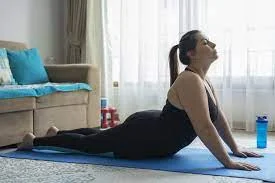
Lay flat on your stomach to perform. Then, with both elbows narrowly bent, push up on your elbows or all the route to your palms of the hand. Even if you might only be able to reach your elbows, that’s fine. In order to look up at the ceiling, extend your neck and head back.
Why it works: This move extends your rectus abdominis and obliques, which are core muscles. These muscles are essential for effective exercises and the well-being of your lower back.
Lunging calf stretch
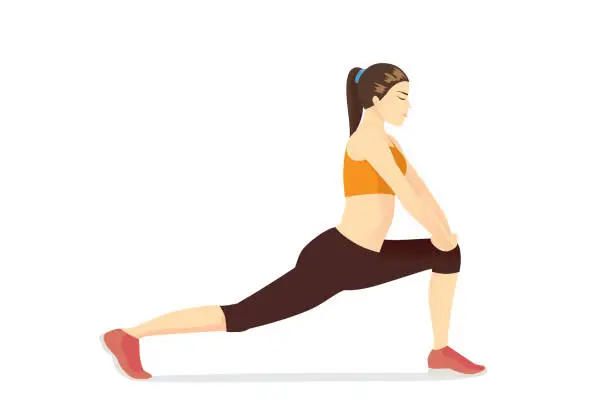
How to perform it: Lunge forward while keeping your back knee raised. To feel the stretch in your back calf, ease into the stretch with a light bounce. Repeat on the opposite side after holding for 30 seconds.
Why it works: The best thing about this stretch is that it works your calves, hip flexors, glutes, and hamstrings. People frequently neglect their calves when cooling down. It works wonders as a wonderful warm-up but is also excellent for stretching your lower body after a grueling HIIT workout or long run.
Seated Pigeon stretch
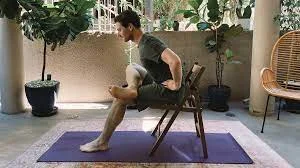
How to execute: Place your right ankle on your left knee while seated on a bench or chair. Then, gently press your right knee toward the floor. Then, exchange to the other leg and preserve for a further 30 seconds. This will aid in avoiding tightness in your inner thighs.
Why it works: Similar to a standing figure four stretch, the sitting pigeon is excellent for focusing on your glutes and enables you to hold the position for however long you need without needing to balance on one foot. By releasing lower back tension, it also helps to enhance hip mobility as well as posture and alignment.
Piriformis stretch
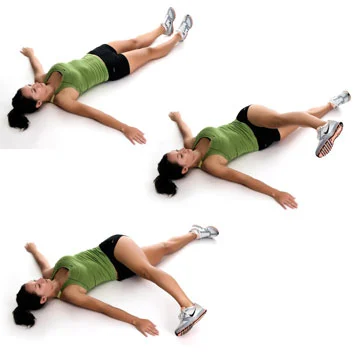
How to execute: Take a seat on the ground with your legs out in front of you. Put your right foot firmly on the ground near your left knee and cross your right leg over your left. Put your right hand behind you while rotating your upper body to the right. As you continue to twist, place your left elbow on your right knee and press outward to deepen the stretch. After holding for 30 seconds, change sides and do it again.
Why it performs: you have ever had leg and lower back pain that shot through you. You would have a sciatic nerve in it. The piriformis, a flat muscle on your butt that is situated close to the top of your hip joint, houses the sciatic nerve. Your piriformis compresses the nerve when it becomes inflamed, which causes pain. After exercising, stretching and strengthening that muscle will help you move more freely and prevent an uncomfortable recurrence
Lunge with A spinal twist
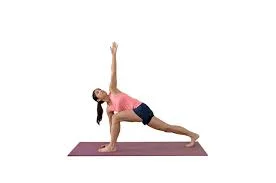
How to execute it: From a standing position, extend your left lunge by taking a large stride forward with your left foot. gradually position of the left foot on the ground/mat. Turn your upper body to the left and raise your left arm toward the ceiling while placing your right hand on the floor near your left foot. After holding for 30 seconds, switch sides and do it again.
Why it works: Mobility is a key factor once more. Your thoracic or mid-back mobility can be greatly improved with this stretch, which is frequently disregarded. It is very simple to modify to fit your current level of flexibility and is excellent for stretching the hip flexors and opening them up.
This is frequently performed faster as a warm-up, so take your time and allow yourself to fully immerse yourself in each action.
Sumo squats stretch
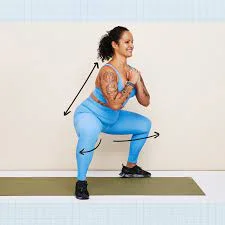
With your feet wider than a hip distance apart, stand up straight.
Deeply squat while placing your elbows slightly above your knees on the insides of your thighs.
Hold the separation of your knees for a few seconds.
Repeat.
The benefits of cool-down exercises
Similar to how a warm-up gets you ready for exercise, a cool-down aids in recovery. A cooldown has the following benefits.
- Exercise recovery is accelerated by reducing exercise intensity and easing out of a session by performing static stretches. Your heart rate, blood pressure, and breathing rate all gradually return to their pre-exercise values as you calm down. This accelerates the healing process and aids in the removal of metabolic waste that accumulates in your muscles during exercise. Additionally, it might assist you in preventing post-workout side effects involve headaches, or vertigo.
- eases stiffness and muscle soreness: Exercise also has the unintended side effect of DOMS or delayed-onset muscle soreness. There is a different analysis of the impact of stretching on muscle feeling uncomfortable. Additionally, the stretching after exercise should be static. However, evidence indicates delayed onset muscle soreness may be reduced with light cardio cooling down.
- Increases range of motion and flexibility: After exerting yourself physically during exercise, targeted static stretches assist in lengthening and relaxing your muscles. This might increase your range of motion and flexibility, making it easier for you to move around during daily activities and subsequent workouts.
- Exercises for the cool-down phase encourage relaxation, flexibility, and the beginning of the healing process.
- You can experience lightheadedness or vertigo if your blood collects in your veins; a slow cooldown maintains your blood flowing.
- Your body temperature, blood pressure, and heart rate can all return to normal after cooling down.
- Lactic acid buildup can be lessened by stretching your muscles while they’re still warm. lowering the risk of stiffness and cramping in your muscles.
- Stretching also lengthens the connective tissue surrounding your joints, boosts mobility, and enhances range of motion.
- Simple and Easy to Do Everywhere: This stretch can be performed in almost any situation, whether standing or sitting, working at a desk cleaning the house, or traveling by vehicle, rail, or other mode of transportation. You don’t require a lot of space or any particular equipment. This stretch can be achieved anywhere and doesn’t even require you to get on the floor, making it a terrific exercise for easing aching muscles quickly.
- Can Be Mild or Strong: The upside to the overhead side reach stretch is that you may adjust the intensity to suit your needs for any given day. If you ever experience extremely severe pain, you might try a gentler variation of this stretch. Sometimes, if you’re feeling particularly flexible, you might push yourself to extend your range of motion.
- stretch the stiff and the core muscles: Your upper and lower back, as well as your core, will be completely stretched if you perform the overhead side reach correctly. Your obliques and latissimus dorsi should feel a significant stretch along the sides of your torso.
- lessens tension in the neck: You’ll experience nearly instant relief of tension if you let your neck descend into the stretch. Just be careful to drop your neck gradually; rapid or jerky motions could cause an injury or an unpleasant pop at the very least.
All of these benefits work to increase your body’s general flexibility and function, which will help you feel better, perform better, and experience fewer injuries.
When to see an advance
If you want help making changes or want to advance your training, think about hiring a personal trainer.
A fitness expert can assist you in creating a personalized cooldown plan based on your needs. If you have any ailments, worry about certain regions, or have particular targets in mind, they may change the type of exercise you undertake.
An expert can ensure you’re performing the exercises properly and offer insightful comments to remain safe while getting the most out of your workout.
The conclusion
After exercising, a cooldown regimen can assist your heart rate in returning to resting levels promote workout recovery, reduce muscular discomfort, and lower your pulse rate.
Lower-intensity aerobics and static or passive stretches that target the muscles you worked during your workout should be included in your cool-down exercises.
The overhead triceps stretch, the seated forward bend, and the knee-to-chest stretch are a few examples of cool-down exercises.
The last thing you would want to do after working out is to cool down. After all, it’s challenging enough to fit in a workout. However, spending more time cooling down is essential for your post-workout recuperation. Skipping it can result in injuries and muscular tightness that can wreck your fitness ambitions.
This crucial exercise doesn’t have to take a lot of time or be difficult. Incorporate 5 to 10 minutes of lower-intensity aerobic and static stretches that concentrate on the muscles you worked throughout your workout as part of your cooldown routine.
Set aside some time after your workout to gently calm down to set yourself up for success. This allows your body to heal, balances your physical functions, and aids in easing you back into the rhythm of your everyday life.
Give yourself just enough energy to finish your cool down without going overboard. Never bounce or force your way into a position; only move to your edge.
You can switch out a portion of your workout and concentrate more on these calming, soothing activities to benefit your mind and body on days when you’re not feeling particularly active or energized.
FAQs
Is stretching a beneficial cool-down technique?
Stretching’s capacity to help your body achieve homeostasis—a crucial component of a cool down—is one of its main advantages. Stretching also reduces heart rate, soothes the nervous system, and restores normal breathing.
What occurs if a cool-down is skipped?
Your blood pressure may rise, your muscles may contract, and your heart rate will all rise during an exercise. If you don’t cool down, you run the danger of getting hurt again, having blood pool in your lower limbs, and putting more strain on your heart.
What workouts are effective for cooling down?
As you calm down, take deep breaths to help your muscles receive oxygen, reduce tension, and encourage relaxation.
brisk walking or jogging. One of the easiest ways to decompress is to do this.
Stretch your upper body.
Forward bend while seated.
Knee to Chest Position.
Butterfly Pose when lying down.
Infant Pose.
should yoga be a cool-down activity?
With or without yoga, the body will naturally calm down. However, yoga provides a number of other advantages in addition to supporting the process, which may be helpful in aiding your client in finishing their workout. Check out these eight postures that work, then incorporate them into your go-to post-workout regimen.
Is relaxation a good way to cool down?
Additionally, relaxation helps the body chill down, relax, and physically soothe you. excellent for post-workout when the body’s systems are high on endorphins substance.
Does breathing exercise help you relax?
After an intense game, to relieve tension after a fight, or even just to recharge and concentrate, breathing exercises might be helpful.
What three kinds of cool-downs are there?
You should incorporate the following three phases of a cool-down after the activity. These include easy exercises like walking, stretches that target different parts of the body, and rehydrating because it’s crucial to replenish fluids lost during activity.
What is class 8 of the cool-down exercises?
Any exercise, physical or mental, that aids in a person’s recovery and physical repair following physical activity or exercise is referred to as a cool down in the setting of physical activity and exercise.
What are two good reasons to relax?
Similar to warming up before a workout, cooling down afterward progressively lowers your heart rate, aids in injury prevention, and stretches you out. It’s all positive! The best part is that cooling down need not be time-consuming. Your body should begin to recuperate after anywhere between four and 10 minutes.
should an individual demand to cool down?
Your heart rate should drop to a level that is near to rest during the cool down. Without a cool-down, stopping abruptly might cause lightheadedness, dizziness, and/or fainting. Walking after running is a wonderful example of a cool-down. Two to five minutes should be allocated for your cool down.
what is An active cool-down exercise?
The preferred kind of exercise is a dynamic whole-body motion that uses more muscular mass, such as walking, jogging, or rowing. Low- to moderate-intensity exercise is recommended to improve blood flow, encourage the reduction of blood pooling at the extremities, and aid in lactate clearance.
what is a passive cool-down?
The list of passive cooldown techniques is not universal but contains sitting, standing, lying down, resting, stretching, foam rolling, vibration treatment, submersion in cold or hot water, and wearing compression clothing.
References
- Try this cool-down routine you can do after every workout. (2023, June 5). TODAY.com. https://www.today.com/health/diet-fitness/cool-down-exercises-rcna24609
- Cronkleton, E. (2019, December 17). 16 Cooldown Exercises You Can Do After Any Workout. Healthline. https://www.healthline.com/health/exercise-fitness/cooldown-exercises#takeaway
- GoodRx – Error. (n.d.). https://www.goodrx.com/well-being/movement-exercise/cool-down-exercises-after-workout
- LaMarco, N. M. (2022, October 19). 14 Cool Down Stretches to Add to Your Workout Routine. Verywell Fit. https://www.verywellfit.com/cool-down-stretches-to-add-to-your-workout-routine-6748990
- Stiefvater, S. (2020, September 29). 10 Cool Down Exercises That Can Make Your Workout More Effective. PureWow. https://www.purewow.com/wellness/cool-down-exercises
- V., & V. (2022, December 28). 12 Best Cool Down Exercises. VTW. https://www.vingo.fit/fitness-for-beginners/how-to-create-a-cooldown-routine/

